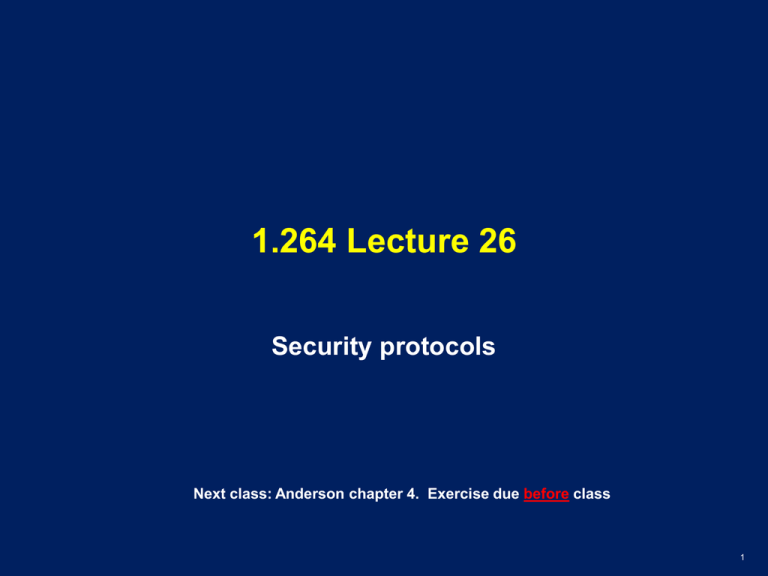1.264 Lecture 26 Security protocols class
advertisement

1.264 Lecture 26
Security protocols
Next class: Anderson chapter 4. Exercise due before class
1
Encryption
• Encryption is the process of:
–
–
–
–
Transforming information (referred to as plaintext)
Using an algorithm (often called a cipher)
To make it unreadable to anyone
Except those possessing special knowledge, usually
referred to as a key.
• The result of the process is encrypted
information, or ciphertext.
• The reverse process, i.e. to make the encrypted
information readable again, is referred to as
decryption, (i.e. to make it unencrypted).
2
Protocols
• Security processes are called protocols. They
address:
– Identity and authentication of identity
– Roles and authorization of roles
– Accounting for resources used by principals
• Including non-repudiation
– Valid and invalid actions taken by principals, including
attackers, e.g.,
•
•
•
•
Man in the middle attacks
Replay attacks, and other issues with freshness/staleness
Tampering with network connections
Impersonation, extortion, physical theft, …
• If your organization has significant assets, you
must protect against sophisticated/tailored attacks
3
Protocol notation example
• Notation
– T -> G : T, {T, N}KT
– Token T used to enter garage G (T and G are principals)
• Token (e.g. like EZ Pass) transmits its serial number T
• Then transmits its serial number T and a number used only
once (nonce) N, encrypted with its key KT
• Nonce assures that message is fresh, not a replay
– Nonce can be sequential, random, or third party challenge
– Assume nonce is sequential in this protocol
• KT known by both T and G
– Parking garage server:
•
•
•
•
•
Reads T
Looks up the corresponding key KT from its database
Deciphers {T, N}KT
Checks that the message includes T, and
Checks that N has not been seen before or has expected value
4
Exercise: flaws in garage protocol?
• Describe whether it is possible to have:
–
–
–
–
–
Man in the middle attack?
Denial of service attack?
Replay attack?
Crack (obtain) the key?
Other attacks that you can imagine?
• Think like a criminal…
5
Solution: flaws in garage protocol?
• Describe whether it is possible to have:
– Man in the middle attack?
• Yes. Have a rogue reader before garage entrance that reads
all EZ Pass units seen. Copy the tag’s message to the reader
onto another unit. Use that one to enter garage.
– Denial of service attack?
• Yes. Break the reader, cut its power, etc. Gate will be left up
– Replay attack?
• No. Since each message has nonce.
– Crack the key?
• Yes. Attacker Z can go into garage with rogue reader and
interrogate an EZ Pass unit repeatedly. Z knows part of the
message is the sequential number and part is the fixed key. Z
can infer KT from enough (N, NKT) pairs
– Other attacks that you can imagine? (Easiest one!)
• Yes. Attacker can break into car and steal EZ Pass unit
6
Exercise: challenge and response
• Vehicle anti-theft system as example
– Vehicle key inserted into steering lock
– Car key has serial number, which is its identifier
– Engine management unit sends random number challenge to
car key using short range radio
– Car key computes response by encrypting the random number
challenge and also sends car key identifier
– Engine management unit decrypts, reads response and
verifies it matches the challenge, and car key serial nbr correct
• Exercise: write out the protocol using the notation
conventions from the last slide:
• E (engine)->_____________________________________
• C (car key) ->____________________________________
7
Solution
• E (engine)-> C (car key): N
• C -> E : {C, N} KC
• Note the car key must send its identifier
– E must verify that C is valid.
– N can often be predicted somewhat because the engine
controller is simple (e.g., black hat intercepts N and knows
next N is based on it)
– Forcing black hat to find C makes break-in significantly harder
– Key and engine management unit must be matched at time of
manufacture; engine management unit must know KC
• Notes:
– The protocol is between a key and the engine. Since the user has the
key, the key and engine are only in proximity when the user is too.
– The key must be in the ignition for the protocol to start. This also
makes the protocol better: contact rather than contactless.
– These factors make man in the middle attacks harder, but not
impossible.
8
Challenge response
• This is very common approach but has been
broken repeatedly
– Random numbers often not very random and can be
grabbed or guessed by thief
• It is also vulnerable to man-in-the-middle attacks
– A <-> B <-> C
– B can masquerade as C, passing A’s requests to C and
sending C’s responses to A. After (fraudulent)
authentication, B gains access
– Parking garage example:
• Black hat has reader, masquerades as garage reader,
interrogates card, gets its serial number T, (N,T)KT , plays it
to real reader, gets response back, enters garage
• Denial of service attack: jam radio frequency so
car owner can’t lock car when leaving
9
Exercise: physical security
• Pharmaceutical anti-counterfeiting
– Manufacturer places bar code or RFID tag on each drug
item
– Store scans bar code or RFID tag to verify authenticity
with manufacturer server
– Customer has 800 number to call to verify serial number
• List possible attacks
– Again, think like a criminal
10
Solution: physical security
• Pharmaceutical anti-counterfeiting
– Place bar code or RFID tag on drug item
– Store scans to verify
– Customer has 800 number to call to verify serial number
• Possible attacks
– Copy bar code or RFID tag and place on counterfeit
item, sell it before the real item
– Set up fake Web site and 800 number that will verify
anything. Alter instructions to stores or consumers
– If store can be compromised, even more attacks are
possible. Store can fail to check, falsify records, etc.
– Supply chain and transportation increasingly involved in
anti-counterfeiting and other security requirements
• These are versions of replay, man in the middle…
11
MIT OpenCourseWare
http://ocw.mit.edu
1.264J / ESD.264J Database, Internet, and Systems Integration Technologies
Fall 2013
For information about citing these materials or our Terms of Use, visit: http://ocw.mit.edu/terms.



